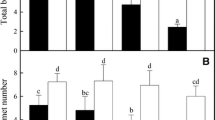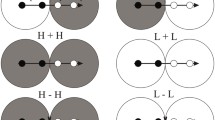Abstract
Clonal herbs form belowground organs where they store reserves and bear regenerative buds. Based on these characteristics, clonal herbs may deal with disturbances better than non-clonal herbs, and clonality is seen as an adaptive strategy in disturbed habitats. The advantage of being clonal is likely to be enhanced in stressful conditions where larger belowground storage is beneficial. We conducted a greenhouse experiment to examine the ability of young plants to deal with biomass removal when exposed to light or nutrient stress or its combination. Using congeneric pairs of species, we evaluated the ability of clonal versus non-clonal groups to cope with biomass removal in terms of mortality, biomass productivity, specific leaf area and root-to-shoot ratio. We found that clonal and non-clonal herbs produce the same amount of biomass when injured and that nutrient and light stress does not alter biomass production. Both groups responded similarly to the biomass removal by increasing the specific leaf area and root-to-shoot ratio. Very young clonal herbs had higher mortality than non-clonal herbs of the same age. This fact suggests a higher survival probability in the non-clonal group, presumably originating from a greater population dependence on generative reproduction. We conclude that belowground organs in young plants, and thus bud banks and belowground storage, are not yet formed enough to give clonal herbs an advantage over non-clonal ones, and the advantage of clonality might manifest later in life when belowground organs are fully developed.





Similar content being viewed by others
References
Aarssen LW (2008) Death without sex – the ‘problem of the small’ and selection for reproductive economy in flowering plants. Evol Ecol 22:279–298
Batzer EE, Martina JP, Elgersma KJ, Goldberg DE (2017) Clonal plant allocation to daughter ramets is a simple function of parent size across species and nutrient levels. Pl Ecol 218:1299–1311
Benot ML, Morvan-Bertrand A, Mony C, Huet J, Sulmon C, Decau ML, Prud'homme MP, Bonis A (2019) Grazing intensity modulates carbohydrate storage pattern in five grass species from temperate grasslands. Acta Oecol 95:108–115
Casper BB, Jackson RB (1997) Plant competition underground. Annual Rev Ecol Syst 28:545–570
Chapin FS, Schulze E, Mooney HA (1990) The ecology and economics of storage in plants. Annual Rev Ecol Syst 21:423–447
Conner JK, Zangori LA (1998) Combined effects of water, nutrient, and UV-B stress on female fitness in Brassica (Brassicaceae). Amer J Bot 85:925–931
Day KJ, Hutchings MJ, John EA (2003) The effects of spatial pattern of nutrient supply on yield, structure and mortality in plant populations. J Ecol 91:541–553
Dong BC, Wang MZ, Liu RH, Luo FL, Li HL, Yu FH (2018) Direct and legacy effects of herbivory on growth and physiology of a clonal plant. Biol Invas 20:3631–3645
Drake PL, Mendham DS, White D, Ogden GN (2009) A comparison of growth, photosynthetic capacity and water stress in Eucalyptus globulus coppice regrowth and seedlings during early development. Tree Physiol 29:663–674
Duchoslavová J, Jansa J (2018) The direction of carbon and nitrogen fluxes between ramets in Agrostis stolonifera changes during ontogeny under simulated competition for light. J Exp Bot 69:2149–2158
Eriksson O, Jerling L (1990) Hierarchical selection and risk spreading in clonal plants. In van Groenendael J, de Kroon H (eds) Clonal growth in plants: regulation and function. SPB Academic Publishing, The Hague, pp. 79–94
Ferraro DO, Oesterheld M (2002) Effect of defoliation on grass growth. A quantitative review. Oikos 98:125–133
Ficken CD, Wright JP (2019) Nitrogen uptake and biomass resprouting show contrasting relationships with resource acquisitive and conservative plant traits. J Veg Sci 30:65–74
Fischer M, van Kleunen M (2002) On the evolution of clonal plant life histories. Ecol Evol 15:565–582
Grubb PJ, Lee WG, Kollmann J, Wilson JB (1996) Interaction of irradiance and soil nutrient supply on growth of seedlings of ten European tall-shrub species and Fagus sylvatica. J Ecol 84:827–840
He T, Lamont BB, Downes, KS (2011) Banksia born to burn. New Phytol 191:184–96
Herben T, Šerá B, Klimešová J (2015) Clonal growth and sexual reproduction: tradeoffs and environmental constraints. Oikos 124:469–479
Hicks S, Turgtington R (2000) Compensatory growth of three herbaceous perennial species: the effects of clipping and nutrient availability. Canad J Bot 78:759–767
Hoffman MD, Gelman A (2014) The No-U-Turn sampler: adaptively setting path lengths in Hamiltonian Monte Carlo. J Machine Learning Res 4:1–30
Janeček Š, Klimešová J (2014) Carbohydrate storage in meadow plants and its depletion after disturbance: Do roots and stem-derived organs differ in their roles? Oecologia 175:51–61
Janovský Z, Herben T (2020) Reaching similar goals by different means - Differences in life-history strategies of clonal and non-clonal plants. Perspect Pl Ecol 44:125534
Keddy PA (2001) Competition. Kluwer, Dordrecht.
Klimešová J, Klimeš L (2008) Clonal growth diversity and bud banks of plants in the Czech flora: an evaluation using the CLO-PLA3 database. Preslia 80:255–275
Klimešová J, Martínková J, Herben T (2018) Horizontal growth: An overlooked dimension in plant trait space. Perspect Plant Ecol 323:18–21. https://doi.org/10.1016/j.ppees.2018.02.002
Lapointe L, Bussieres J, Crete M, Ouellet JP (2010) Impact od growth form and carbohydrate reserves on tolerance to simulated deer herbivory and subsequent recovery in Liliaceae. Amer J Bot 97:913–924
Liu HD, Yu FH, He WM, Chu Y, Dong M (2007) Are clonal plants more tolerant to grazing than co-occurring non-clonal plants in inland dunes? Ecol Res 22:502–506
Martínková J, Klimeš A, Klimešová J (2020a) Young clonal and non-clonal herbs differ in growth strategy but not in aboveground biomass compensation after disturbance. Oecologia 193:925–935
Martínková J, Klimeš A, Puy J, Klimešová J (2020b) Response of clonal versus non-clonal herbs to disturbance: different strategies revealed. Perspect Pl Ecol 44:125529
Maschinski J, Whitham TG (1989) The continuum of plant responses to herbivory: the influence of plant association, nutrient availability, and timing. Amer Nat 134:1–19
McKinley DC, Van Auken OV (2005) Influence of interacting factors on the growth and mortality of Juniperus seedlings. Amer Midl Naturalist 154:320–330
Moore NA, Camac JS, Morgan JW (2018) Effects of drought and fire on resprouting capacity of 52 temperate Australian perennial native grasses. New Phytol 221:1424–1433
Ott JP, Klimešová J, Hartnett DC (2019) The ecology and significance of below-ground bud banks in plants. Ann Bot (London) 123:1099–1118
Ottaviani G, Lubbe FC, Lepš J, Lisner A, Martínková J, Mudrák O, Klimešová J (2021) Strong impact of management regimes on rhizome biomass across Central European temperate grasslands. Ecol Applic 31:e02317
Paula S, Ojeda F (2009) Belowground starch consumption after recurrent severe disturbance in three resprouter species of the genus Erica. Botany 87:253–259
Pennings SC, Callaway RM (2000) The advantages of clonal integration under different ecological conditions: a community-wide test. Ecology 81:709–716
Pérez-Harguindeguy N, Díaz S, Garnier E, Lavorel S, Poorter H, Jaureguiberry P, ... Cornelissen JHC (2013) New handbook for standardised measurement of plant functional traits worldwide. Aus J Bot 61:167–234. https://doi.org/10.1071/BT12225_CO
R Core Team (2016) R: a language and environment for statistical computing, R Foundation for Statistical Computing, Vienna. Available at https://www.r-project.org
Reich PB (2014) The world-wide ‘fast–slow’ plant economics spectrum: a traits manifesto. J Ecol 102:275–301
Šmilauerová M, Šmilauer P (2007) What youngsters say about adults: Seedling roots reflect clonal traits of adult plants. J Ecol 95:406–413
Stan Development Team (2018) RStan: the R interface to Stan. R package. Retrieved from http://mc-stan.org/
Thalmann M, Santelia D (2017) Starch as a determinant of plant fitness under abiotic stress. New Phytol 214:943–951
Van Der Heyden F, Stock WD (1996) Regrowth of a semiarid shrub following simulated browsing: the role of reserve carbon. Funct Ecol 10:647–653
Wan JZ, Wang CJ, Yu FH (2019) Large-scale environmental niche variation between clonal and non-clonal plant species: roles of clonal growth organs and ecoregions. Sci Total Environm 652:1071–1076
Weiser M, Koubek T, Herben T (2016). Root foraging performance and life-history traits. Frontiers Pl Sci 7:779
Wilson SD, Tilman D (1993) Plant competition and resource availability in response to disturbance and fertilization. Ecology 74:599–611
Wise MJ, Abrahamson WG (2005) Beyond the compensatory continuum: environmental resource levels and plant tolerance of herbivory. Oikos 109:417–428
Wise MJ, Abrahamson WG (2007) Effects of resource availability on tolerance of herbivory: a review and assessment of three opposing models. Amer Naturalist 169:443–454
Wright IJ, Reich PB, Westoby M, Ackerly DD, Baruch Z, Bonger F, Cavender-Bares J, Chapin T, Cornelissen JHC, Diemer M, Flexas J, Garnier E, Groom PK, Gulias J, Hikosaka K, Lamon BB, Lee T, Lee W, Lus C, Midgle JJ, Nava ML, Niinemets Ü, Oleksyn J, Osada N, Poorter H, Poot P, Prior L, Pyanko VI, Roumet C, Thoma SC, Tjoelker MG, Veneklaas EJ, Villar R (2004) The worldwide leaf economic spectrum. Nature 428:821–827
Zhu C, Chen Y, Li W et al (2014) Effect of herbivory on the growth and photosynthesis of replanted Calligonum caputmedusaesaplings in an infertile arid desert. Plant Ecol 215:155–167. https://doi.org/10.1007/s11258-013-0286-7
Acknowledgements
The work was supported by the Czech Science Foundation (grant No. 19-13231S) and by the long-term research project of the Czech Academy of Sciences RVO 67985939. We would like to thank Tomáš Herben for valuable methodological and statistical advice.
Author information
Authors and Affiliations
Corresponding author
Additional information
Publisher’s Note
Springer Nature remains neutral with regard to jurisdictional claims in published maps and institutional affiliations.
Rights and permissions
About this article
Cite this article
Martínková, J., Klimeš, A. & Klimešová, J. Effect of nutrient and light stress on the mortality and growth of young clonal and non-clonal herbs after biomass removal. Folia Geobot 56, 99–108 (2021). https://doi.org/10.1007/s12224-021-09395-7
Received:
Revised:
Accepted:
Published:
Issue Date:
DOI: https://doi.org/10.1007/s12224-021-09395-7




